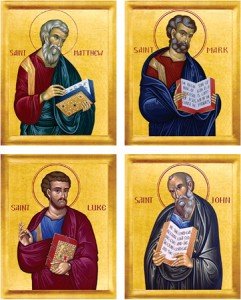 Many scholars believe that the remarkable concordance found among the three Evangelists is the result of a primitive oral gospel. In its most extreme form this solution excludes any common literary dependence on a single written Gospel. The primitive preaching became stereotyped at an early date. This preaching was constantly repeated. The similarities in the written texts are thus accounted for; the dissimilarities are explained by the diversification of the same catechesis necessary in various areas. To support the existence of such a primitive catechesis the extraordinary memory of the Oriental is invoked. As we consider Judaism and Islam we understand how very important memorized texts are.
Many scholars believe that the remarkable concordance found among the three Evangelists is the result of a primitive oral gospel. In its most extreme form this solution excludes any common literary dependence on a single written Gospel. The primitive preaching became stereotyped at an early date. This preaching was constantly repeated. The similarities in the written texts are thus accounted for; the dissimilarities are explained by the diversification of the same catechesis necessary in various areas. To support the existence of such a primitive catechesis the extraordinary memory of the Oriental is invoked. As we consider Judaism and Islam we understand how very important memorized texts are.
Doubtless a period of oral tradition did precede our written Gospels. Modern criticism almost universally admits to the primacy and importance of oral tradition in the Gospels. But the supposition of an oral tradition alone cannot account for the very complex problem found in the three Gospels of similarities and dissimilarities in the written texts. There is in many passages an exact verbal agreement, especially in Mark and Luke. Oral tradition can explain the divergences in the Gospels but not the similarities. These would seem to demand some literary dependence as well. Thus the theory of an oral tradition being the basis of the Synoptic Problem seems to be an inadequate answer.
A second theory is called the Literary Interdependence. This type of hypothesis is also known as the Mutual-Dependence Theory and the Use or Utilization Theory. According to this hypothesis, each Evangelist (except the first) depended upon his predecessor or predecessors. The first of the Gospels in date was followed by the two others as derivatives. This would explain the points of agreement among the Synoptics. There are several possible orders of dependence, each having had its proponent at one time or another. Only two of these combinations have really been able to hold any ground. They are: Matthew as the source of Mark and Luke OR Mark as the source of both Matthew and Luke.
During the coming weeks I would like to share with you other various solutions to the Synoptic Problem and also provide an evaluation of each of the solutions according to biblical scholars. I think it is imperative that we have a good sound understanding of the Gospels so that they can play a real part in our spiritual development. Hopefully you will find this valuable.
